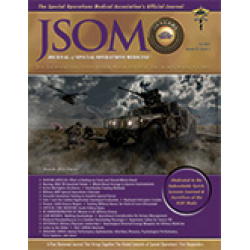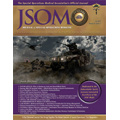Performance Evaluation of the Solo-T and the Combat Application Tourniquet in a Perfused Cadaver Model
Holinga GJ, Foor JS, Van Horn SL, McGuire JE 22(3). 49 - 55 (Journal Article)
Purpose: We evaluated a 10.2-cm-wide, minimally elastic, adhesive wrap-based tourniquet (Solo-T or ST) alongside a 3.8-cm-wide windlass-based tourniquet (Combat Application Tourniquet Generation 7, or CAT) to determine if the tension wrap-tightened ST could deliver hemorrhage control equivalent to the windlass-tightened CAT. Methods: A cadaver model was used to simulate lower-thigh femoral arterial hemorrhage at "normal" (146 ± 5mmHg) and "elevated" (471 ± 3mmHg) perfusion pressures (mean ± standard error). Three study participants used the ST and CAT to control hemorrhage during 48 timed trials. Arterial occlusion was established by Doppler ultrasound and tourniquet performance was quantified by under-tourniquet pressure cuffs. Results: Participants achieved 100% (24/24) occlusion success rates and reported similar ease of use for both tourniquets. Occlusion and application times (mean ± standard error) were similar (p > .05) for the ST and CAT under "normal" (occlusion, ST: 25 ± 2 seconds, CAT: 22 ± 2 seconds; application, ST: 27 ± 2 seconds, CAT: 26 ± 2 seconds) and "elevated" (occlusion, ST: 24 ± 7 seconds, CAT: 24 ± 7 seconds; application, ST: 25 ± 7 seconds, CAT: 25 ± 7 seconds) perfusion alike. The ST mean completion pressures (mean ± standard error) were > 40% lower than the CAT under both "normal" perfusion (ST: 110 ± 20mmHg; CAT: 210 ± 30mmHg; p = 0.009) and "elevated" perfusion (ST: 190 ± 50mmHg; CAT: 340 ± 30mmHg; p = 0.03). Conclusion: The adhesive wrap-based ST tourniquet delivered equivalent hemorrhage control performance at significantly lower completion pressures than the CAT.


 Español
Español 




